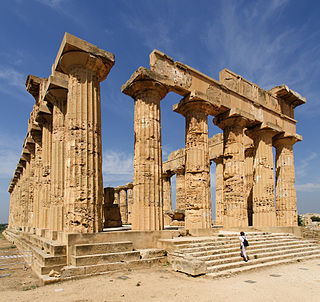
Selinunte was a rich and extensive ancient Greek city of Magna Graecia on the south-western coast of Sicily in Italy. It was situated between the valleys of the Cottone and Modione rivers. It now lies in the comune of Castelvetrano, between the frazioni of Triscina di Selinunte in the west and Marinella di Selinunte in the east.

Greek temples were structures built to house deity statues within Greek sanctuaries in ancient Greek religion. The temple interiors did not serve as meeting places, since the sacrifices and rituals dedicated to the respective ouranic deity took place outside them, within the wider precinct of the sanctuary, which might be large. Temples were frequently used to store votive offerings. They are the most important and most widespread building type in Greek architecture. In the Hellenistic kingdoms of Southwest Asia and of North Africa, buildings erected to fulfill the functions of a temple often continued to follow the local traditions. Even where a Greek influence is visible, such structures are not normally considered as Greek temples. This applies, for example, to the Graeco-Parthian and Bactrian temples, or to the Ptolemaic examples, which follow Egyptian tradition. Most Greek temples were oriented astronomically.

Paestum was a major ancient Greek city on the coast of the Tyrrhenian Sea in Magna Graecia. The ruins of Paestum are famous for their three ancient Greek temples in the Doric order, dating from about 550 to 450 BC, which are in an excellent state of preservation. The city walls and amphitheatre are largely intact, and the bottom of the walls of many other structures remain, as well as paved roads. The site is open to the public, and there is a modern national museum within it, which also contains the finds from the associated Greek site of Foce del Sele.

Metapontum or Metapontium was an important city of Magna Graecia, situated on the gulf of Tarentum, between the river Bradanus and the Casuentus. It was distant about 20 km from Heraclea and 40 from Tarentum. The ruins of Metapontum are located in the frazione of Metaponto, in the comune of Bernalda, in the Province of Matera, Basilicata region, Italy.
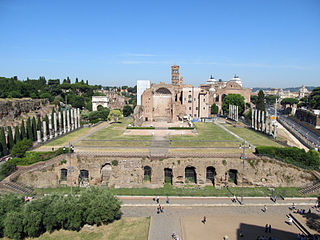
The Temple of Venus and Roma is thought to have been the largest temple in Ancient Rome. Located on the Velian Hill, between the eastern edge of the Forum Romanum and the Colosseum, in Rome, it was dedicated to the goddesses Venus Felix and Roma Aeterna.
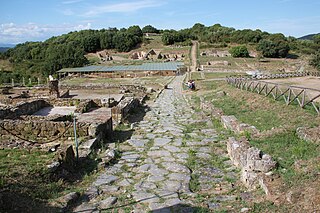
Rusellae was an important ancient town of Etruria, which survived until the Middle Ages before being abandoned. The impressive archaeological remains lie near the modern frazione or village of Roselle in the comune of Grosseto.

The Temple of Zeus at Olympia was an ancient Greek temple in Olympia, Greece, dedicated to the god Zeus. The temple, built in the second quarter of the fifth century BC, was the very model of the fully developed classical Greek temple of the Doric order.

The Heraion of Samos was a large sanctuary to the goddess Hera, on the island of Samos, Greece, 6 km southwest of the ancient city of Samos. It was located in the low, marshy basin of the Imbrasos river, near where it enters the sea. The late Archaic temple in the sanctuary was the first of the gigantic free-standing Ionic temples, but its predecessors at this site reached back to the Geometric Period of the 8th century BC, or earlier. As a testimony to the mercantile and naval power of Samos during Archaic Greece, and its exceptional architecture, the site of temple's ruins, with its sole standing column, was designated a UNESCO World Heritage Site, along with the nearby archeological site Pythagoreion in 1992.
A Heraion or Heraeum is a temple dedicated to the Greek goddess Hera

Lagina or Laginia (Λαγινία) was a town in the territory of Stratonicea, in ancient Caria. It contained an important temple of Hecate, at which every year great festivals were celebrated. Tacitus, when speaking of the worship of Trivia among the Stratoniceans, evidently means Hecate. Its site is located near Turgut, Asiatic Turkey.

Lycosura was a city in the ancient Parrhasia region of south Arcadia said by Pausanias to be the oldest city in the world, although there is no evidence for its existence before the fourth century BCE. Its current significance is chiefly associated with the sanctuary of the goddess Despoina, which contained a colossal sculptural group that Pausanias wrote was made by Damophon of Messene. This group comprises acrolithic-technique statues of Despoina and Demeter seated on a throne, with statues of Artemis and the Titan Anytos standing on either side of them – all in Pentelic marble. The dates of both the temple and the sculptural group have occasioned some dispute. Remains of a stoa, altars, and other structures have been found at the site as well. The Sanctuary of Despoina at Lycosoura is located 9 km WSW of Megalopolis, 6.9 km SSE of Mount Lykaion, and 160 km SW of Athens. There is a small museum at the archaeological site housing small finds as well as part of the cult group, while the remains of the cult statues of Despoina and Demeter are displayed at the National Archaeological Museum of Athens.

The Temple of Aphaia or Afea is located within a sanctuary complex dedicated to the goddess Aphaia on the Greek island of Aigina, which lies in the Saronic Gulf. Formerly known as the Temple of Jupiter Panhellenius, the great Doric temple is now recognized as dedicated to the mother-goddess Aphaia. It was a favourite of the Neoclassical and Romantic artists such as J. M. W. Turner. It stands on a c. 160 m peak on the eastern side of the island approximately 13 km east by road from the main port.
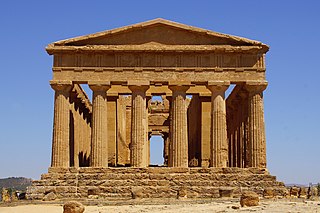
The Valle dei Templi, or Valley of the Temples, is an archaeological site in Agrigento, Sicily. It is one of the most outstanding examples of ancient Greek art and architecture of Magna Graecia, and is one of the main attractions of Sicily. The term "valley" is a misnomer, the site being located on a ridge outside the town of Agrigento.
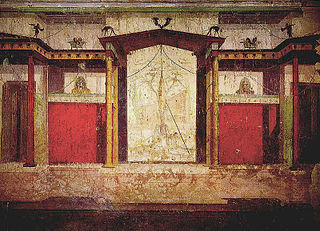
The House of Augustus, or the Domus Augusti, is situated on the Palatine Hill in Rome, Italy. This house has been identified as the primary place of residence for the emperor Augustus.

Tas-Silġ is a rounded hilltop on the south-east coast of the island of Malta, overlooking Marsaxlokk Bay, and close to the town of Żejtun. Tas-Silġ is a major multi-period sanctuary site with archaeological remains covering four thousand years, from the neolithic to the ninth century AD. The site includes a megalithic temple complex dating from the early third millennium BC, to a Phoenician and Punic sanctuary dedicated to the goddess Astarte. During the Roman era, the site became an international religious complex dedicated to the goddess Juno, helped by its location along major maritime trading routes, with the site being mentioned by first-century BC orator Cicero.

The Temple of Artemis is an Archaic Greek temple in Corfu, Greece, built in around 580 BC in the ancient city of Korkyra, now called Corfu. It is found on the property of the Saint Theodore monastery, which is located in the suburb of Garitsa. The temple was dedicated to Artemis. It is known as the first Doric temple exclusively built with stone. It is also considered the first building to have incorporated all of the elements of the Doric architectural style. Very few Greek temple reliefs from the Archaic period have survived, and the large fragments of the group from the pediment are the earliest significant survivals. It was excavated from 1911 onwards.

The Heraion at Foce del Sele is an archaeological site consisting of an Ancient Greek sanctuary complex dedicated to the goddess Hera in Magna Graecia. It was originally located at the mouth of the Sele, about 8 km (5.0 mi) north of the Greek city of Poseidonia, famous for its three standing Greek temples, but is now about 2.3 km (1.4 mi) from the modern coast as a result of the deposition of alluvial sediment by the river. The site is in the modern commune of Capaccio-Paestum, some 80 km (50 mi) south of Naples.

The Temple of Hera or Heraion is an archaic temple in Corfu, Greece, built around 610 BC in the ancient city of Korkyra, in what is known today as Palaiopolis, and lies within the ground of the Mon Repos estate. The sanctuary of Hera at Mon Repos is considered a major temple, and one of the earliest examples of archaic Greek architecture.

The National Archaeological Museum of Metaponto is a museum housing the archaeological finds from the Greek city of Metapontum, now Metaponto, Basilicata, Italy. It replaces the small Antiquarium built near the Heraion outside the walls of the Tavole Palatine.
The First Temple of Hera (Paestum)—also known as Temple of Hera I and the Basilica—is an archaic Doric temple located in the ancient city of Paestum, Italy. This Doric temple is considered one of the oldest Greek temples in Italy and is known for its distinctive architectural features. It was built around 550–525 BCE, within a century of the city's establishment by Greek colonists from Sybaris, who named the city Poseidonia.



















